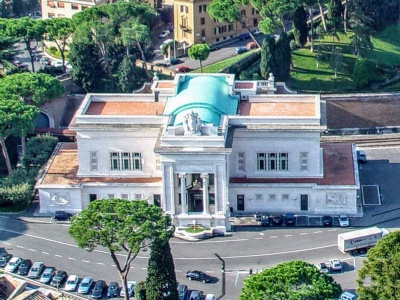Vatican City State
In central Rome lies the sovereign enclave and microstate Vatican City and St. Peter’s Basilica, seat of world’s catholicism and the Pope himself. St. Peter’s Basilica is dedicated to the apostle Peter, who died in 64 AD, and was consecrated in 1626 by Pope Urban VIII. The pope is the head of the Roman catholic church, the head of state of the Vatican and the holder of the Holy See. The Vatican has a long Catholic history but became independent only in 1929 after a long conflict with the Italian royal house. As an independent state, it is externally completely independent of other states. Its size is not more than 0.44 square kilometers and the population is not more than about 800 people.
During the war Pius XII was pope and the Vatican declared itself neutral in the war that broke out in September 1939. As the main seat of the Roman Catholic church, both Mussolini and Hitler had to pursue a restrained and balanced policy against the pope and the Vatican because both German and Italian citizens, including soldiers, confessed themselves to the Roman catholic church. Attacking the Pope and the Vatican could have had devastating consequences for both of them.
Hitler understood that the church and the pope had a strong position in the state and the church understood that Hitler and Nazism were a political movement that, might not threaten the position of the church, but well challenged it. As early as July 1933, a concordat was concluded between the Roman Catholic Church (Holy See) and the German empire (of which the nazis were a part). This concordat guaranteed the Roman Catholic Church the right to exist in the German empire while bishops, when they took office, swear allegiance to the president of the German empire. The basic idea of the concordat was that church and state should coexist but not interfere in each other’s affairs. When President Hindenburg died in August 1934, the presidency was abolished, which meant that allegiance was henceforth sworn directly to Hitler as the supreme leader of the German empire (Führer).
The Concordat did not forbid bishops and priests to criticize the (Nazi) state, but at the same time, it did not forbid the (Nazi) state to arrest clergymen if the state considered them a threat. For instance, criticism was expressed against the Nazi euthanasia program and anti-Jewish politics. Even the pope himself took a stand on certain issues, which led the German foreign minister Joachim von Ribbentrop to visit the pope in 1940 to clarify why the pope had taken a stand against Germany. The pope replied that it was because of the war crimes committed by the Germans against church representatives (both Jews and Christians) in both Germany and Poland. After the war, the pope has been criticized for not taking a clear stand against the destruction of Jews during the war.
During the war, the Vatican was bombed twice, but with minimal material damage and human losses. The first time occured November 5th, 1943, when 4–5 bombs were dropped southwest of the Basilica’s Dome and caused damage to the train station and the Palace of the Governorate, but no human casualties. It has never really been established who dropped these bombs. The Second time occured March 1st, 1944, when, during a mission over Rome, British RAF dropped six bombs that unfortunately hit the Vatican outer wall, killing one person and injuring another person. At both times, Rome was under German occupation.
Current status: Preserved (1998).
Location: 41°54'03.75" N 12°27'04.27" E
Get there: Walk.
Follow up in books: Kertzer, David: The Pope at War: The Secret History of Pius XII, Mussolini and Hitler (2022).


The material damages that occurred during the bombings was repaired, but as a memory that the war also affected the Vatican City, some of the shattered facade of the train station has been preserved.
Vatican City, in particular St. Peter’s Basilica, is a popular destination for tourists (and pilgrims) travelling to Rome. The train station and other buildings damaged by the bombings are located behind St. Peter’s Basilica where few tourists goes. The small train station is still in use. As a parenthesis, the Concordat is still valid and in force.